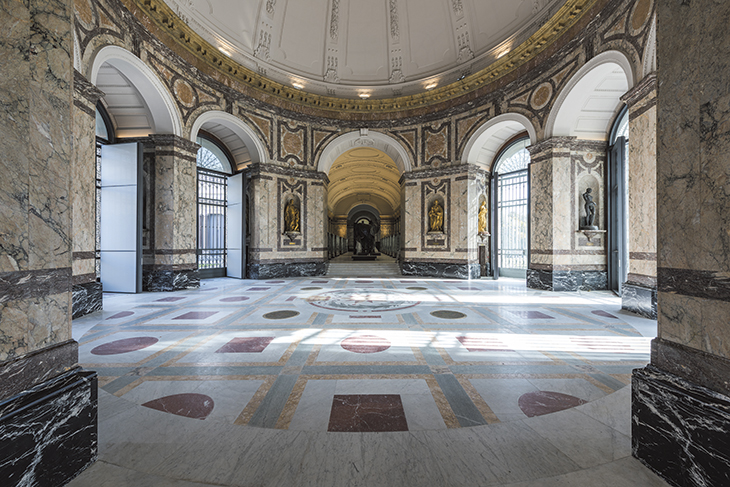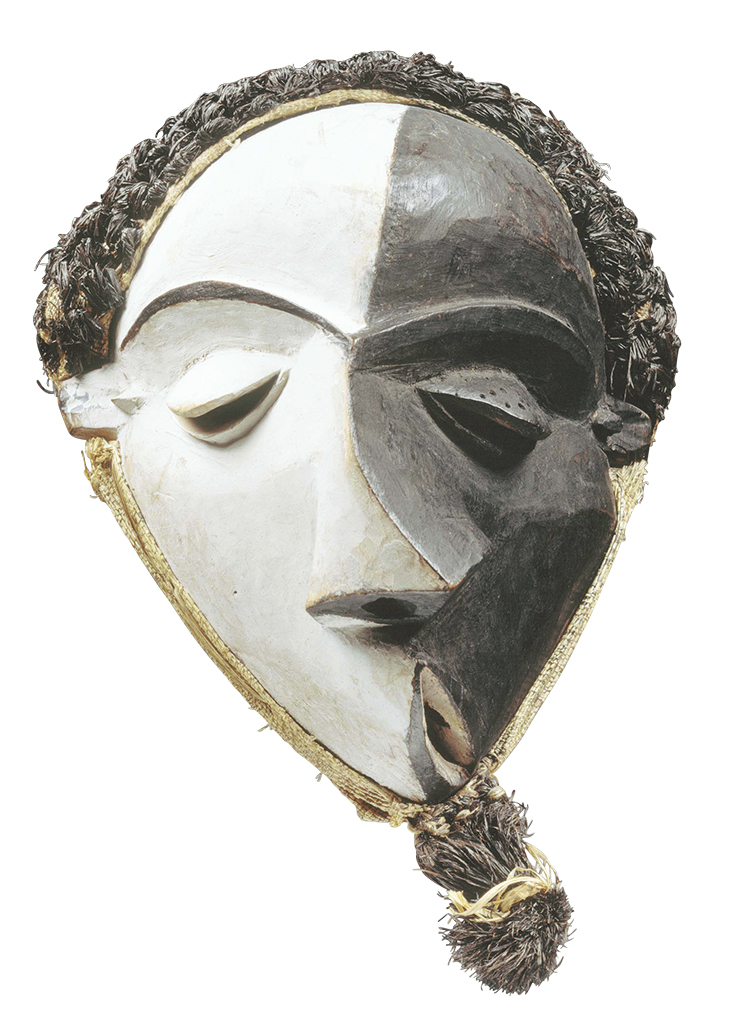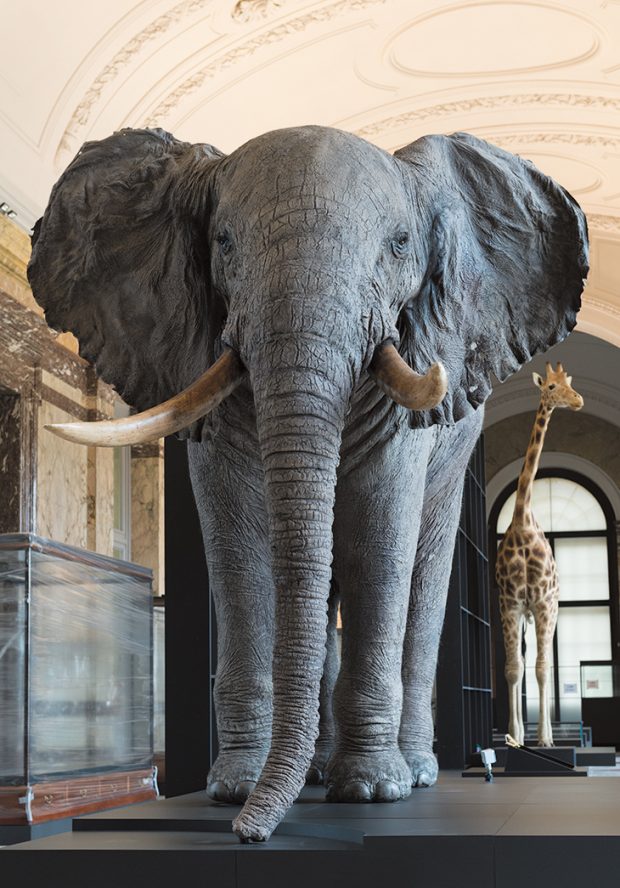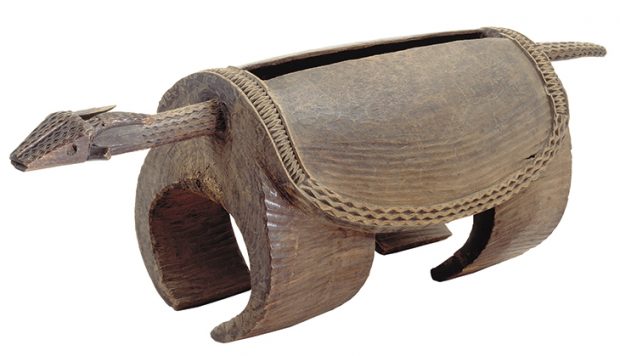‘Mercilessly death reaped the ranks of the first pioneers. Never will we pay enough tribute to their memory.’ So reads an inscription in the Memorial Hall of the Africa Museum (formerly the Royal Museum for Central Africa). The words in French run beneath a list of names, the 1,508 Belgians who died in Congo between 1876 and 1908. The institution has its origins in the Brussels International Exposition of 1897. The Colonial Pavilion, located at Leopold II’s estate at Tervuren, formed the basis of the museum intended to show off what the king regarded as his achievements in what was then the Congo Free State – Leopold’s personal possession until 1908, when it was transferred to the Belgian state for tens of millions of francs and the settlement of his debts. The Museum of Belgian Congo opened in 1910, a year after Leopold’s death. (After the Congo became independent in 1960, the museum became the Royal Museum for Central Africa.)
I am at the museum just outside Brussels in early December, ahead of its reopening after a five-year renovation. What has been derisively called ‘the last colonial museum in the world’ has now nearly doubled its public areas. A brand-new rectangular glass building sits a few hundred metres from the main one designed by Charles Girault, the architect of the Petit Palais in Paris. The original museum building and the new one are connected by an underground tunnel, which contains a new exhibition space that can be subdivided by a state-of-the-art moveable wall. In the new building there are conference rooms, auditoriums equipped for music and dance performances, locker and picnic rooms for schoolchildren, educational spaces, and a restaurant overlooking the museum’s grounds – an elegant park in the French style that runs into another 205 hectares of woodland.
The great rotunda of the Africa Museum in Tervuren. Photo: Jo Van de Vyver; © RMCA Tervuren

Inside the old building, across the walls, there are more signs of Belgium’s colonial exploits in Congo, or what a leading figure in that quest, Henry Morton Stanley, described as ‘the last place on earth that man has not yet discovered’. In the grand rotunda, with a dome that reaches tens of metres into the sky, there are gold-leaf and bronze statues (the former by Arsène Matton) with titles such as Belgium Brings Civilisation to Congo and Belgium Brings Security to Congo. They show African figures as childlike and naive, at the feet of their masters, or holding spears and wearing leaf skirts to show off rippling muscles or voluptuous breasts. On the floor of the rotunda there is a double ‘L’ back-to-back in mosaic, the insignia of Leopold II. This same mark is reproduced in the cornicing and appears 45 times throughout all the rooms and corridors. ‘His eyes are on us everywhere,’ the museum’s director Guido Gryseels tells me, slightly mischievously.
The original building was so cold and echoey it was an endurance just getting through it. Cabinets of curiosity lined the walls of the rooms and inside them, under accumulating layers of dust, the arts and artefacts of Central Africa – mostly from the Belgian Congo (now the Democratic Republic of Congo) – were intermingled with animal parts in formaldehyde jars and balding stuffed animals. The huge windows were covered with black tape to protect exhibits from the sunlight – ‘After 3.30 you couldn’t see anything,’ Gryseels recalls – and in winter they let in wafts of icy air. Visitors were offered visions of the Congo through rooms presenting thematic displays of its environment, spiritual practices, and folklore. Masks and jewellery, cooking implements, musical instruments, and the flora and fauna were all on display, but the displays were intended to celebrate Belgium’s rule – Congo belonged to Belgium, in the original incarnation of the museum. The Congolese were subjects, a source of intrigue and exoticism who were by turns primitive and erotic. Their voices were never heard.
Mbanga mask (n.d.), Central Pende, Bandundu, Democratic Republic of Congo. Africa Museum, Tervuren. Photo: Jo Van de Vyver; © RMCA Tervuren

Now the black tape has been ripped off, the windows are double-glazed and covered by elegant blinds that filter the light in a soft glow. The original elements – the bronze and gilt statues, painted wall maps and memorials – have been carefully restored to their former glory. However, the museum in its original form never mentioned the millions of people who died during Leopold’s ruthless extraction of natural resources from the Congo Free State. Instead it paid homage to its missionaries and explorers, those who brought the contents of the museum back to Belgium in the spirit of the mission civilisatrice. The only place the subjects of the Africa Museum had was at the feet of their colonial masters. Yet all the traces of the colonial mindset are still present, as vivid as when the museum first opened more than a hundred years ago, if now presented more critically.
The renovation began in 2013 and the museum’s reopening has coincided with a revival in the debate over the restitution of art from Africa in European museums. In 2017 President Macron announced in Ouagadougou that he wanted to oversee the return of African art to Africa. The inquiry he commissioned from two academics was published last November and the Africa Museum seems contrary to the spirit of its recommendations of wholesale restitution. A colonial-era museum with one of the world’s most important collections of Central African art – including some 120,000 ethnographic artefacts, 170,000 photographs and 10,000,000 zoological specimens – has undergone a €66.5m modernisation that has not so far involved any relocation or major repatriation of its collection.
Helmet mask (second quarter of the 19th century), Luba, Democratic Republic of Congo. Africa Museum, Tervuren. Photo: Jo Van de Vyver; © RMCA Tervuren

Historically Belgium has been reticent to the point of denial about the reality of Leopold’s personal rule or the later colonial period. ‘In every Belgian family there was always someone who worked in the Congo,’ says Gryseels, ‘so every family was almost emotionally attached. It was a very emotional thing and Belgium was not up to [confronting] it.’ The first breaking of the silence came in the 1990s. The publication in 1998 of King Leopold’s Ghost: A Story of Greed, Terror and Heroism in Colonial Africa by the American writer Adam Hochschild was something of a turning point. The stomach-churningly brutal story of the administration of the Congo Free State was out of the bag. It was the first time these things had ever been said so publicly, and a jolt for those of Gryseels’s generation. ‘I never got any critical note whatsoever during my education,’ he says, recalling the stories he grew up with, of missionaries and nuns who ‘all did a fantastic job educating people’.
The exposure combined with Belgium’s changing demographics. Today in Brussels a quarter of the city’s population is Muslim and many complain of a lack of job opportunities, difficulty finding adequate housing, widespread discrimination and racism. In 2016 the centre of the Islamic State cell that had organised the attacks in Paris at the Bataclan and around the city was found in Molenbeek, a district in Brussels. In March that year the Belgian capital was hit by a coordinated suicide bombing, also claimed by Islamic State and killing more than 30 people. A deep social malaise within immigrant communities in the country was now under the spotlight. One factor cited was the absence of an honest reckoning in the country with its colonial past contributing to an ongoing, latent racism.
By keeping the Africa Museum intact, Belgium’s uncomfortable history has become part of what is on display. This is lost when museums or collections move, as in the case of the Quai Branly in Paris, which combines collections from the Musée de l’Homme and the now-shut National Museum of African and Oceanian Art. A relocation or dispersal of a collection can also be a way of shutting down the difficult conversations that could be had about where the collections have come from and how they should be presented in a way that takes this into account.
A mounted and elephant and giraffe in the ‘Landscapes and Biodiversity’ gallery. Photo: Jo Van de Vyner; © RMCA Tervuren

The Africa Museum has decided to tackle this head-on, by giving its collection a new lease of life. A very visible example is the transformation of the animals. They have all had their fur restored and undergone fresh stuffing, and, in some cases, the testicles have been restored; previously it was forbidden to display the sexual organs of animals, so all the gorillas or monkeys had had them sewn into their stomachs. As I wander among the animals lying on the ground or on tables, in various states of repair, thinking about the second lives they are about to lead, I come across a mound of fresh manure, neatly deposited on a square plinth. ‘For exhibiting,’ Gryseels tells me matter-of-factly, as though I am enquiring about a vase.
This fresh manure is indeed part of the display. As part of the museum’s redefinition of its mission, Gryseels and his team have organised competitions to commission new work to run alongside existing collections, to provide counterpoints to the colonial material on display, as well as acquiring already-existing work by contemporary Central African artists. All this material is shown in parallel with the original collection. The museum’s vast archive of photographs and ethnographic films, for example, will be displayed with commentary from contemporary artists explaining what they see, as a break with the gaze so long being on them. It is rare to see ethnographic material, particularly items that are so important and so disturbing, displayed in such a disruptive way.
Less successful, to my mind, is how some of the contemporary art has been interwoven with the historical displays. A room dedicated to recounting the cycle of life in Congo in five stages, for example, shows cooking utensils and hair combs, traditional masks and weapons alongside paintings depicting scenes from Congolese life in the 21st century, including protest art made during demonstrations against female rape, and fabrics made and worn for special occasions. In another room dedicated to the region’s diversity, a robot has been specially made by Thérèse Ir Izay Kirongozi, an engineer who has designed and replicated hundreds of such robots used today in the DRC to direct traffic.
One of the most powerful rooms in the museum is the ‘Crocodile Room’, which retains its original features – glass cabinets are choc-a-bloc with jars containing various parts of the animal anatomies, with two full-size stuffed crocodiles in the middle. On the walls a painted frieze depicts idealised scenes of Congolese life. However, from one entrance the room is viewed from the observation space of its doorway, which is blocked at the base so visitors cannot enter but are instead encouraged to look dispassionately at the colonial spirit that once animated the museum.
Zoomorphic slit drum (before 1894), Democratic Republic of Congo. Africa Museum, Tervuren. photo: Jo Van de Vyner; © RMCA Tervuren

The long gallery dedicated to the colonial period itself was, Gryseels says, a difficult one to get right. The exhibits here include metal spiked handcuffs and ankle cuffs – literally the chains of the master – and items such as notebooks and measuring tools used on expeditions. Among the standout displays in other rooms are exquisite leather and wood-carved drums, and a collection of extraordinary tiny wooden pot lids carved with figures and objects representing proverbs; these had a dual function in households: to cover food and to settle family disputes. Perhaps most impressive of all are what Gryseels calls proudly the chef d’oeuvres of the museum, pieces that are considered fine art, and presented without the contextualising panels that accompany all the other exhibits – to encourage our seeing them as art rather than ethnographic artefacts. In this temporary exhibition ‘From the Collection: Unrivalled Art’ four glass cabinets contain masks, statuary, and sculpted ivory, nearly all from Congo and mostly from the 19th and first half of the 20th century.
The question of repatriation is unavoidable, and Gryseels acknowledges the importance of this process, but he insists it is not a priority for the Africa Museum. ‘Nobody in Africa is asking for the complete return of objects,’ he says, ‘[…] they just want to have better access to it and also some collections to complete their own collections.’ On the whole he has found more enthusiasm from museums in Africa for the digitisation of collections and inventories, so that these museums know what they could ask for on a loan basis. And previous repatriation efforts have been something of a cautionary tale. In the 1970s Belgium returned more than a hundred objects to Congo but, Gryseels says, ‘a few years later most of this was stolen’ and went on the international market. Now there are only 24 of those objects left in the country, he says. The high-profile reopening of the Africa Museum has led to fresh calls from campaigning groups and even the current president of the DRC for items to be returned to the country – and such calls are only likely to grow in force. (Since this interview took place, Gryseels has stated that the museum is open to the return of works, subject to investigation into what was legally and illegally acquired.)
Réorganisation (2002), Chéri Samba. Africa Museum, Tervuren. © Chéri Samba

At one point during my visit, as we are walking through the new underground tunnel, Gryseels stops me suddenly and takes out his phone to take a photograph of a painting on the wall. It is the first time he has seen it unveiled. The painting shows him standing with his arms folded on the steps of the museum, an expression of concern mixed with sternness on his face. On one side a group of African men and women are pulling out a statue of the museum’s controversial ‘Leopard Man’ figure. At the doors of the museum are some Europeans tugging at the cart being wheeled out, trying to hold on to the statue. A message is written next to Gryseels: ‘It’s true that it’s sad but actually the museum must be fully reorganised.’ Réorganisation (2002) is the title of the painting, and the museum commissioned it from Congolese contemporary artist Chéri Samba. It will appear displayed in a room with the Leopard Man statue and other artefacts that are controversial but also well-known in the museum’s collection, and it is a good summing up of what the museum wants to say about itself. It captures the message Gryseels wants to project to the world – a museum, and its director, fully aware of its ugly heritage but unwilling to get rid of it all in a panic.
This new chapter for the Africa Museum has been 15 years in the making and it aims to account for decades of silence. Should the museum be seen to fail in its attempt to address its colonial roots while at the same time fulfilling the role of museums as universal space, this may suggest that such a task is simply too difficult. And in an atmosphere of restitution and reckoning, does the Africa Museum succeed in presenting a radically new narrative for the country, through its collections? By and large, it does. It has made concessions, and not all of those are wise, but the museum has such a refreshingly practical response to the repatriation disputes – digitisation of collections and openness to loans, as a starting point – that any underwhelming extras are quickly forgotten, overtaken by the bigger story it is trying to tell.
From the January 2019 issue of Apollo. Preview the current issue and subscribe here


